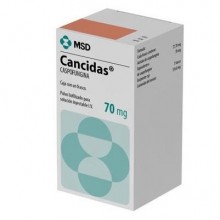



Cancidas has antifungal effects.
Esophageal candidiasis, oropharyngeal candidiasis, aspergillosis.
1 bottle contains caspofungin 70 mg; excipients: sucrose, mannitol, glacial acetic acid, sodium hydroxide
Caspofungin is marketed under different brands and generic names, and comes in different dosage forms:
| Brand name | Manufacturer | Country | Dosage form |
|---|---|---|---|
| Cancidas | vials | ||
| vials |
No customer reviews for the moment.
IV drip, for at least 1 h.
Esophageal and oropharyngeal cadidosis: 50 mg 1 time per day.
Aspergillosis: on the first day, a single daily loading dose of 70 mg is administered. In the following days, the daily dose is 50 mg 1 time per day, if necessary, the dose can be increased to 70 mg 1 time per day. The duration of treatment depends on the severity of the underlying disease, recovery after immunosuppression, and the patient's clinical response.
Frequent (more than 1/100): hyperthermia, headache, abdominal pain, chills, nausea, diarrhea, vomiting, increased activity of "liver" enzymes (ALT, ACT, ALT, direct and indirect bilirubin), hypercreatininemia, anemia, phlebitis / thrombophlebitis, skin rash, itching.
Allergic reactions (rash, swelling of the face, itching, sensation of heat, bronchospasm), anaphylaxis (shortness of breath and increased rash that arose earlier during the use of the drug).
Changes in laboratory parameters: hypoalbuminemia, hypoproteinemia, hypokalemia, hyponatremia, hypocalcemia, decreased Hb, leukopenia, eosinophilia, thrombocytopenia, neutropenia, increased APTT, increased prothrombin time, proteinuria, erythrocyturia, leukocytium,
Hypersensitivity to any component of Cancidas.
Carefully: combination with cyclosporine; in patients with moderate hepatic impairment (from 7 to 9 points on the Child-Pugh scale).
Do not mix with other solutions (including those containing dextrose). Compatible with 0.9% solution of NaCl, Ringer's lactate.
Efavirenz, nelfinavir, nevirapine, rifampicin, dexamethasone, phenytoin, or carbamazepine, while they are given at the same time, lead to a decrease in plasma caspofungin concentration.
It does not affect the pharmacokinetics of itraconazole, amphotericin B, rifampicin, or mycophenolate mofetil active metabolites.
Reduces the concentration of tacrolimus.
Cyclosporine increases AUC by 35%.
Rifampin can both accelerate and slow the elimination of caspofungin.
Clinical experience in the use of Cancidas in pregnant and lactating women is not. In animals, caspofungin penetrates the placental barrier. Caspofungin should not be administered to women during pregnancy, except when prescribing the drug is vital.
Since there is no data on the allocation of caspofungin with the milk of a nursing woman, if necessary, the appointment of the drug during lactation should stop breastfeeding.
Symptoms: there were no clinically significant symptoms when used in the highest dose - 210 mg.
Treatment: hemodialysis is ineffective.
Studies and clinical trials of Caspofungin (Click to expand)